Boats for the Future
Wooden boats that sailed for millennia are still being built in the village of Thaikkal, a fishing hamlet in the southern Indian state of Tamil Nadu, India. This is in spite of technological advancements in the maritime world, the development of road and rail infrastructure especially in post-independence India, the containerisation of the maritime trade by large shipping agencies, and state policies that favour large corporations. The list of odds against the wooden sailing vessels extends on, and yet they manage to find a niche, ensuring their survival, at least for the time being. Through this study we examine a series of factors – economical, environmental, political, and social – that has affected this craft and reflect on the questions that emerged out of our decade-long study.
List of Terms
Nautical Terms
rake: the sloping angle of a ship's bow or stern
stern: rear end of a boat
bow: the forward part of the hull of a boat
draft: submerged part of the boat, usually measured from the waterline to the bottom most part of a boat.
Vernacular Terms
padagu: boat
paai: sail
vathal: wooden barge
mistri: master carpenter
tindal: captain of a boat
kotia: wooden cargo boat built in Cuddalore, Tamil Nadu, India.
thoni: wooden cargo boat built in Tuticorin, located in southern Tamil Nadu, India.
We felt dwarfed against the huge wooden frames of a boat that resembled the whale bones in a natural history museum. It was our first visit to the small boat yard in the village of Thaikkal, on the southern outskirts of Cuddalore town, Tamil Nadu, India, where a community of fisher-carpenters with tools and know-how were building ocean-crossing wooden vessels. A sense of amazement set in due to the fact that wooden cargo ships were still being built at a time when the maritime trade is dominated by massive steel cargo ships, which carry enormous cargoes and berth in deep water ports. In 2013, when we first visited, we did not know that we would return to this boatyard for the next ten years to study, learn, and document the way the wooden cargo ships were built, and that we would get to know the community of fisher carpenters that continue this collaborative work through technological innovations and an astute business sense.
Boats of the Coromandel: Past to the present
Wooden cargo ships have been built on the Coromandel coast – the east coast of the peninsular India – for the last two millennia. References to wooden ships are found in the literature, 1 but only scattered references are available from temple inscriptions. However, there is a complete lack of evidence on the communities that built these boats or the types of vessels that were built. Fast forward to the 20th century, when James Hornell (1918) writes his observations on the lighters and barges with sails in Tuticorin that ferried cargo to and from the steamers anchored mid-sea. According to Hornell, the lighters initially resembled the English design with square stern. The lighting trade was thriving. The local fishermen over the years made modifications to suit the local needs, but they were also influenced by the design of the Arab vessels that traded from the Persian Gulf to Bombay and Tuticorin. The rake of the bow and stern kept reducing, and the resulting design looked quite alike the plank-built canoe, Hornell observes. Some enterprising boat owners built larger versions called the padagu and sailed them exclusively for coasting trade. Eventually these vessels came to be called thoni, for which Tuticorin is famous.
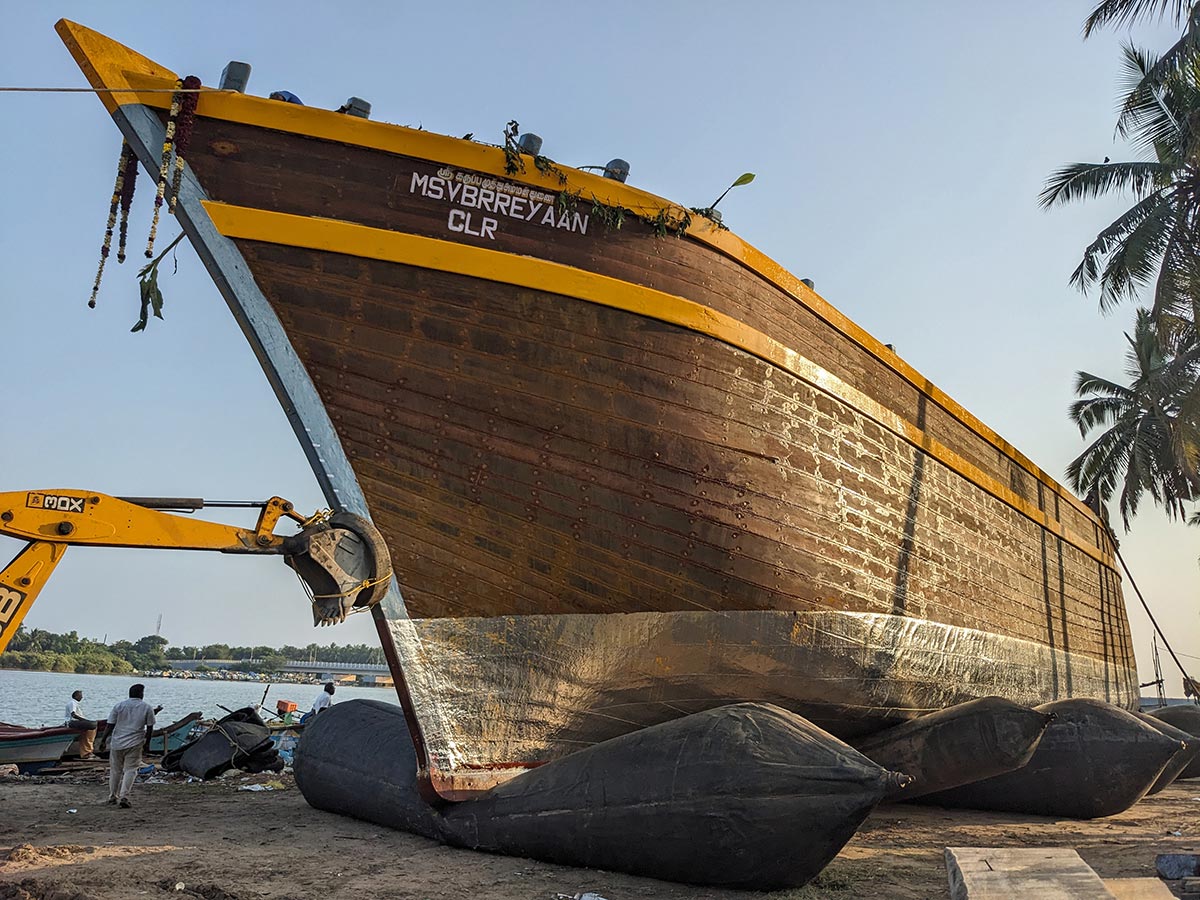
Fig. 2: A newly built kotia, ready to be launched. [Photo courtesy of the authors, 2024]
Meanwhile, in the coastal town of Cuddalore, the British colonial power set up Fort St. David along with a port by the mid-18th century. The port, now located in the old part of the town, was active until as late as the 1990. Steamers and ships docked mid-sea, owing to the lack of draft in the port. This spawned a thriving lighterage trade. The lighters of Cuddalore were called vathal, typically with a five to 20-ton capacity, which ferried cargoes from and to the docked ships. A number of families were involved in this trade as lascars, carpenters, and mistri (master carpenters), who played a crucial role in building and repairing these wooden vathals. Ayyadurai, one of the elders of the Thaikkal village, was born in the 1930s and had been a sailor and owner of vathals. He possessed a canny business sense and, with the help of the local fisher-carpenters, embarked on a new project of building a larger vathal in the 1950s with a capacity of 75 tons, meant for the coasting trade. The vessel he built kept the existing functional design of the lighting vathal and enlarged it proportionately. Relying on sails, these large vathals now travelled long distances for coastal trade. Thus was born the paai vathal of Cuddalore (paai = sails).
Over the years, the 75-ton paai vathal doubled in size to 150 tons. In Tuticorin, further south of Cuddalore, the thonis have grown in size as well, carrying up to 400 tons. These wooden cargo vessels were the mainstay of the coastal trade. They carried vegetables, coconuts, and pottery to Sri Lanka, and they transported rice from the eastern coast to Kerala and Mangalore. After unloading at Mangalore, they would sail further north laden with tiles and sand needed for the ceramic factories around Bombay (Mumbai) and further up to the state of Gujarat. On the return journey, they bring wheat and other goods. By the 1970s, wooden cargo vessels played a major role in moving over one million tons of cargo along the Indian coast. In 1982, the Cuddalore-made paai vathal took an evolutionary step forward to keep up with times. This time, too, it was an initiative by Ayyadurai to fit an engine to the sailing vessel. This meant the design had to be reworked to accommodate the heavy, vibrating diesel engine and a propeller. The addition of the engine gave birth to a hybrid vessel, which earned legal recognition as a Mechanised Sailing Vessel (MSV), while locally it earned the name "kotia."

Fig. 3: Masts are used as derrick to load and unload cargo more often than to rig sails. [Photo courtesy of the authors, 2017]
Life of a kotia: Materials, skills, and sustainability
The building of a kotia begins with a discussion between the owner and the mistri. The owner puts forth his expectation of carrying capacity of the kotia, and then the mistri works out the dimensions and comes up with an estimate of how much the whole endeavour would cost. Once the two are in agreement, the owner makes the funds available in a phased manner.
The mistri then begins to source required wood and put together a team of carpenters and helpers. For the keel and the frames, wood with high density and high oil content is preferred, because such wood in an event of impact would only chip off and not break into pieces. 2 While timber merchants in the region might stock these woods, the mistri taps into his own network of woodcutters who may know if a suitable species of tree is about to be cut. Much of the wood is sourced from private farms and temple lands, particularly for Iluppai (Mahua - Madhuca longifolia); with conservation efforts gaining momentum, sourcing wood from the forests of Western Ghats is reducing. The unfortunate felling of old trees as part of road expansion projects sometimes also becomes sources of wood. There are brokers who roam around a radius of 50-70 km, send pictures of the trees to be cut to the mistri, and act as middlemen in supplying wood. Huge trees such as the Malaysian sal from Southeast Asia and other species from central Africa are used for planks.
It takes a team of about 15-20 carpenters, five helpers, and at least a three-member team of ironsmiths to fabricate and supply 1.5 tons of nails. A caulking team of 10 with its own mistri ensures the kotia is watertight. A five-member team of painters, engine mechanics, electricians, and fiberglass fabricators also play their parts. Altogether, 50 people directly or indirectly work on building a kotia.
The mistri assembles such a diverse team from the vicinity. Most crafts in the Indian context are closely associated and practiced by caste groups. The transfer of knowledge is often guarded within the community. But in the case of building a kotia, although the majority of the workers hail from the fishing community, those from outside of it are also welcome. We have, during the course of our study, met a mistri from a different caste whose primary occupation was agriculture. We have similarly had migrant workers from eastern Uttar Pradesh working as helpers at the boat yard. On average, most workers get a daily wage of 900 Indian Rupees (~10 Euros). The mistri in fact gets only 100 rupees more than the rest of the workers.
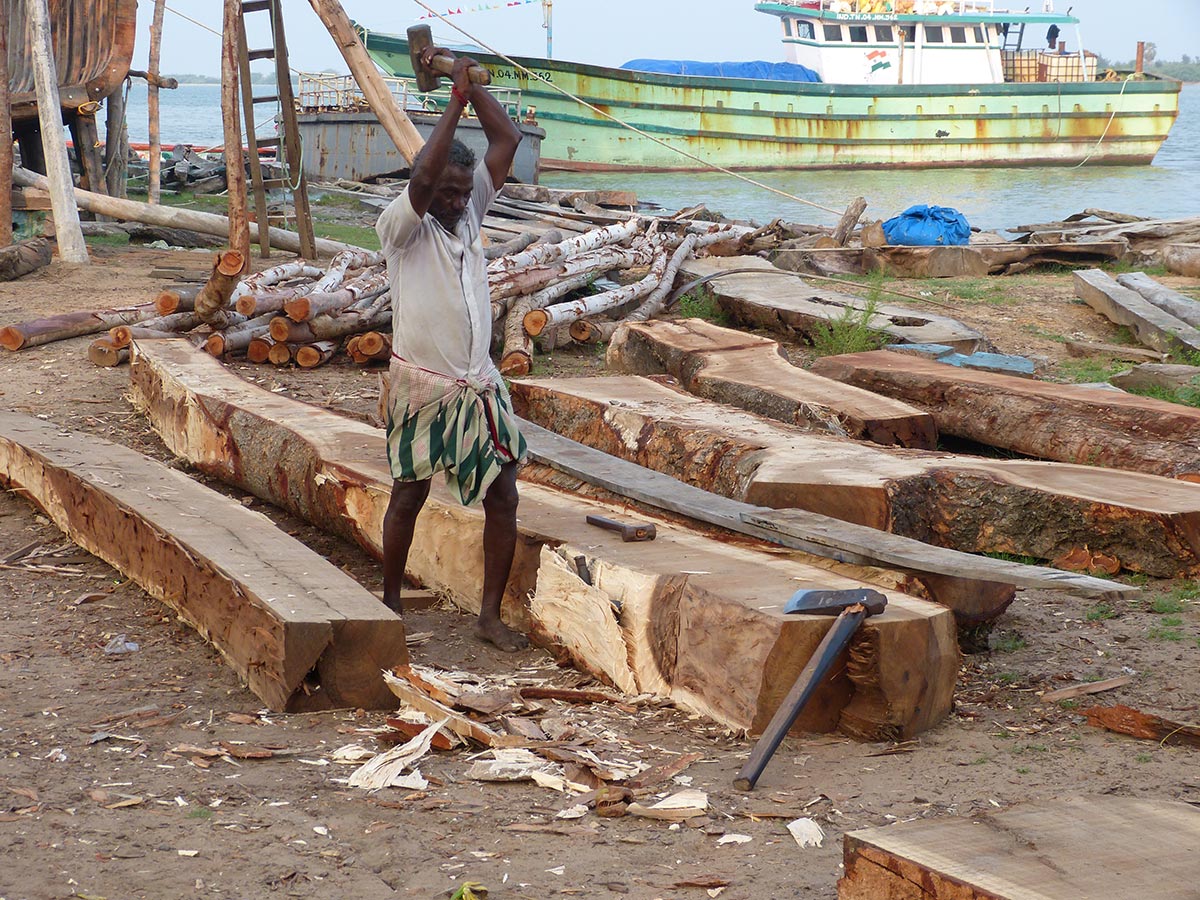
Fig. 4: Axeman sizing a frame. [Photo courtesy of the authors, 2013]
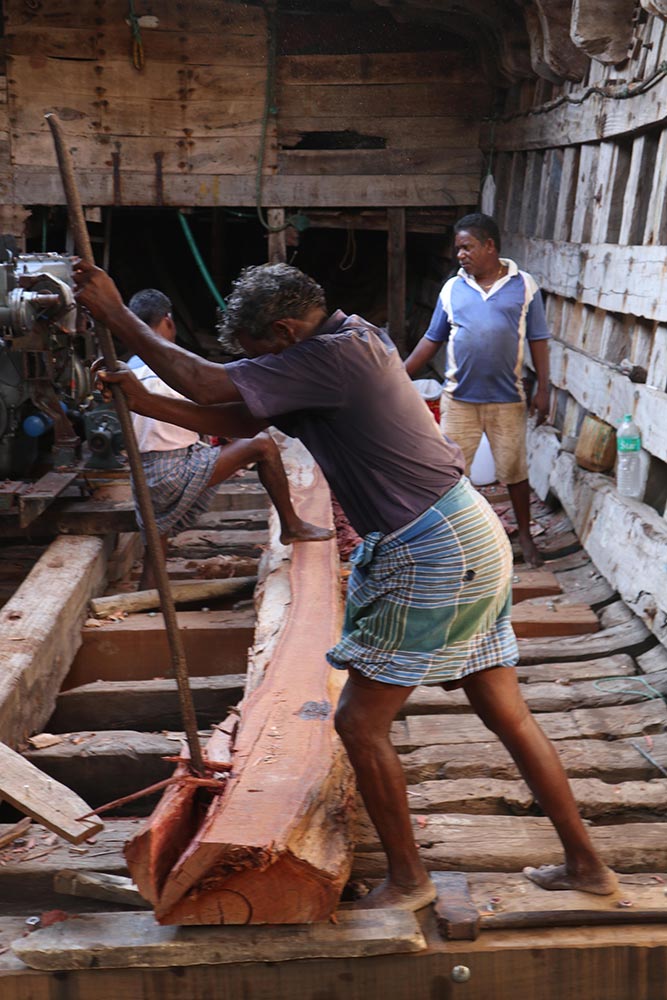
Fig. 5: Strengthening the hull. [Photo courtesy of the authors, 2021]
A good majority of workers were school dropouts or at most completed high school. At the boatbuilding yard on the riverbank of Thaikkal, their long apprenticeship begins with the basic task of helping the carpenters. As Kathiravan, a mistri who collaborated with us throughout the study period said about himself, “no one will teach you how to hold a chisel. You observe others and begin to work with the chisel, the seniors will watch your work and give crucial tips once they see that you are interested in learning.” Today the fisher-carpenters of the Cuddalore region have built up such a reputation that teams are regularly dispatched to Mangalore on the west coast, where they repair and refit wooden cargo vessels.
A newly built kotia typically runs for 8-10 years before requiring a thorough refit. At this stage, some frames and several planks are replaced, engines are overhauled, and the ship is ready to set sail for another eight years or so. By that time, most owners – barring mishaps in mid-sea resulting in total loss – claimed to have recovered their investments and reaped considerable profit. With every refit the kotia gets a fresh lease of life. We have seen a vessel that was still sailing 70 years after it was made. Some may argue that wooden cargo boats accelerate deforestation. However, a careful comparison of the environmental footprint of a steel boat, whose lifespan is less than 25 years and by the end of its life will have to be destroyed, tells us the wooden cargo boats fare better. 3 They can be renovated to become a new ship every decade, and because it is made of wood, the removed parts degrade naturally and thus produce less environmental pollution. If their hybrid nature of using engines and sails for propulsion is augmented, they might make more sense in the long term for environmental sustainability.
Crew and revenue sharing
Typically, a crew of eight to ten members work on a kotia. This includes the tindal or captain, the driver manning the wheels and maintaining the engine, and the lascars. It is also common for one or two apprentices to work on board, and they often start their careers as cooks. Among the fishing community it is common practice to share the revenue generated from the (fish) catch. Similarly, on a kotia, out of the total revenue generated, 65 percent of the share is given to the owner. The remaining 35 percent is shared among the crew. The tindal gets two shares, the driver gets 1.5 shares, and the lascars get one share each. If there is an apprentice, he gets half a share. An interesting factor that we have observed was the acquisition of knowledge through apprenticeship. Most tindals we spoke with started at the bottom of the hierarchy as a cook and acquired the necessary knowledge of navigation to become a tindal. Another aspect we observed was that the experienced crew members do not hesitate to shift roles and attend to the need at hand to ensure smooth sailing.
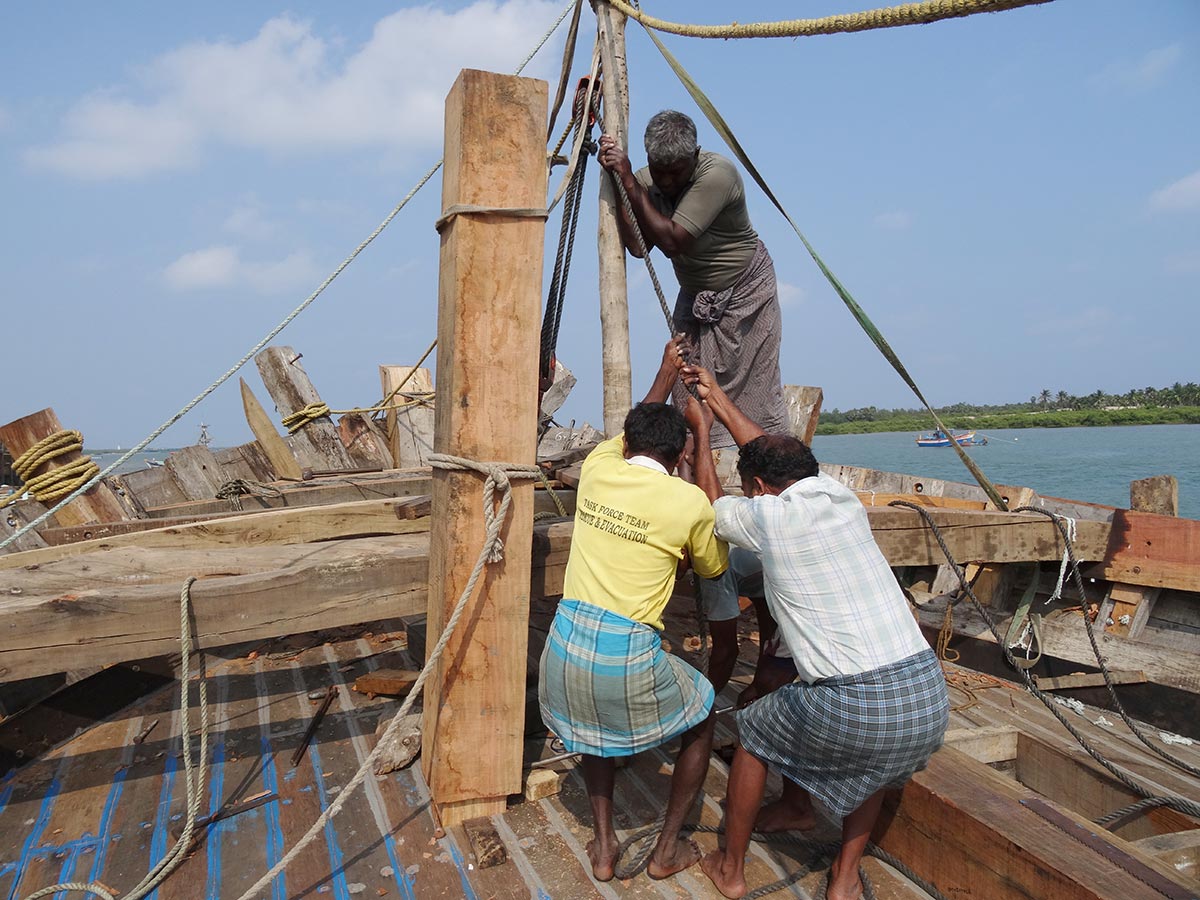
Fig. 6: Fisher-carpenters manoeuvring a heavy piece of wood. [Photo courtesy of the authors, 2014]
Challenges and adaptations
In maritime trade today, the norms are capital-intensive gigantic cargo vessels, containerisation, and deep water ports. These changes, which began globally in the 1960s, have adversely impacted the wooden cargo vessels. For example, they were not allowed to berth alongside steel cargo ships because a collision would completely wreck the wooden boat. Oftentimes, wooden cargo vessels were forced to wait for days outside of port before they were given the clearance to dock and unload the cargo. If the vessel was carrying perishable cargo, a few extra days of waiting meant huge losses. Moreover, wooden sailing vessels were not efficient at braking and changing course compared to the fossil-fuel powered cargo ships that could make quick manoeuvres. For this reason, wooden sailing vessels were considered dangerous on busy shipping lanes.
In the 1950s, the Indo-Norwegian Project gave a push for mechanisation and improved efficiency in the fishing industry in India. Imported diesel-powered engines were being fitted in a variety of the vessels. We understand from our interviews with the fisher-carpenters of Cuddalore that while they welcomed the introduction of diesel engines in fishing vessels, the design of the engine itself was not suited to the local environment. The oil-cooled engines proved to be high-maintenance. They then embarked on modifying the cooling unit of the engine to use sea water instead of oil. This they achieved with an Ashok Leyland truck engine. Adapting this customised engine to the sailing vessels gave birth to the mechanised sailing vessel (MSV). This mechanisation brought better manoeuvrability which helped them to survive the challenges posed by the mainstream maritime industry.
Finding niches for survival
The Indian state recognises the MSVs (kotias) as traditional vessels, meaning that its crew members are exempt from the mandatory training seamen and captains have to undergo. As one kotia owner told us, if this recognition is revoked and seaman training is made mandatory, then he would be obliged to pay monthly salaries on par with a merchant navy. It will render the kotia trade totally unviable.
Large cargo ships and containerisation could move huge amounts of cargo at a reduced freight cost. The development of rail and road networks, especially along the west coast since the 1990s, have almost killed the kotia trade along the west coast. The banning of kotia at all Sri Lankan ports for geopolitical reasons ruined the Ceylon trade for which the Tuticorin thonis were known. Trade with the Maldives has considerably dwindled as the Maldivian authorities have started demanding passports of Indian sailors. The traditional sailor card issued by the local port authority is all the legal paper the crew members carry. However, these challenges failed to eliminate the kotia trade. When the coastal trade dwindled, the kotia owners found lucrative business ferrying goods to islands of Lakshadweep. The seas around these islands are shallow. The populations are low, so the quantities of cargo needed are also relatively low. The kotias, it turned out, are best suited for this environment. As Kathiravan mistri explained to us, the design of the Cuddalore-made kotia barely needs a draft of seven or eight feet to sail into any shallow port. Today, for most of the kotia owners the Mangalore-Beypore-Lakshadweep route provides the bulk of the annual trade.

Fig. 7: Inside the hull of a kotia. [Photo courtesy of the authors, 2014]
In the post-pandemic scenario, Roshan Fernando, a kotia (thoni) owner from Tuticorin, says that he could transport cargo on wooden thonis for almost half the cost of what a container-based shipping company would charge. Celestine Villavarayar, hailing from a Tuticorin family that has been in shipping for generations, said that his grandfather had a fleet of thonis and had earned the title of “Sea King.” Though stevedoring has become the primary business of the family, he built a kotia at Cuddalore in 2013, not just in the memory of his grandfather or to keep the heritage alive, but also for the fact that it is economically profitable.
Lessons and the future
When researchers study craft practices as forms of knowledge, they tend to see them through the lens of dichotomies such as codified knowledge versus tacit knowledge. Observing the craft of building wooden cargo ships for a decade shows us that this craft does not fit well into any such dichotomies. For one, no mistri we spoke with studied ship architecture, and there are no written manuals they follow to build these wooden cargo boats. There are no guides for the axeman on how to size the wooden log into a perfectly fitting frame. The boat yard is a chaotic place. So many activities happen simultaneously, it seems everybody and every small team is working on their own. The mistri may not oversee each task, yet ensures that everyone’s work synchronises to achieve the overall process of building. On more than one occasion, we have also seen an experienced mistri work under a younger mistri. This is because, in this craft practie, transmission of knowledge and know-how travels both ways.
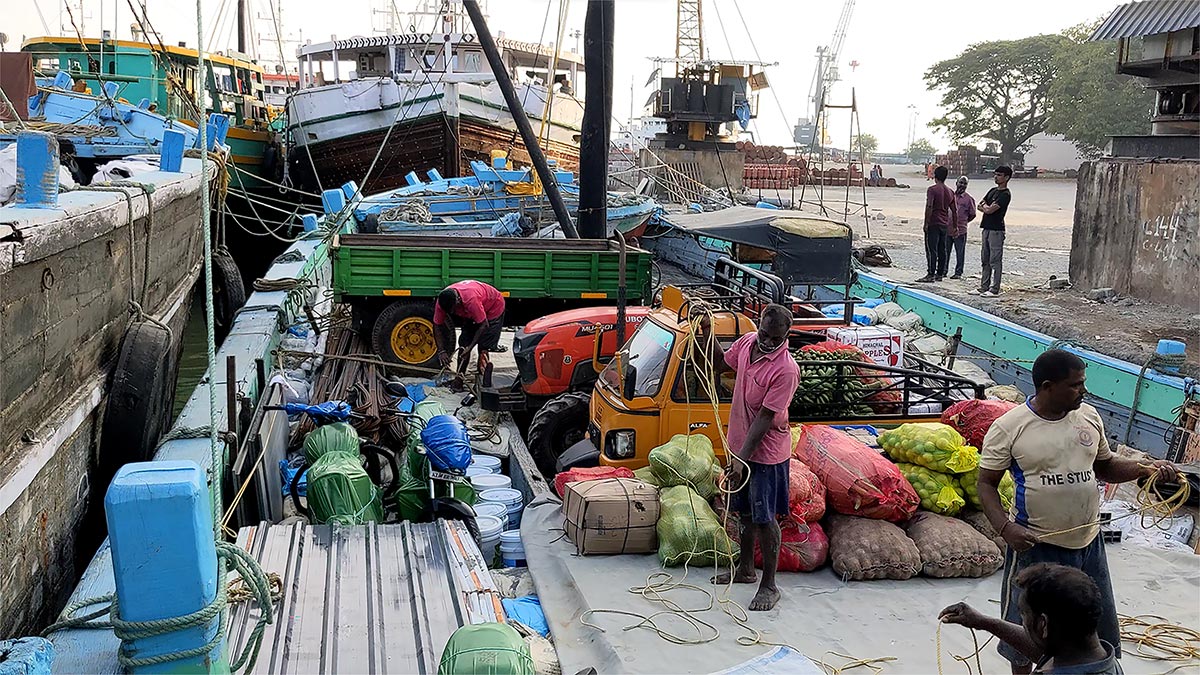
Fig. 8: A kotia at the Mangalore port, laden with cargo preparing to sail to Lakshadweep. [Photo courtesy of the authors, 2023]
We are also conditioned to understand craft as something delicate, precise, or meditative. Boatbuilding, on the other hand, requires raw muscle power of multiple men to move heavy wooden logs and hammer six-inch nails. Many of these activities are dangerous. Yet the vessels they build cross oceans, provide livelihood, and contribute to the economy.
Strict regulations in Europe to reduce environmental pollution in the maritime traffic is pushing the maritime industry to reintroduce wind propulsion and cut down emissions. On the other hand, the hybrid nature of the kotias – using the sail to save on fuel consumption – demonstrates an environmentally friendly and an economically viable model. We hope that such artisanal practices, which have been reinvented in changing contexts, are studied more closely, as this could potentially lead to inspirations and an exchange of ideas. Such exchanges can help address existing environmental challenges, meet economic needs, and also sustain traditions such as the wooden cargo boats.
Gopinath Sricandane leads several archival projects at the Institut Français de Pondichéry (IFP) and specialises in visual documentation. Email: gopinath.s@ifpindia.org
Balasubramanian Dhandapani is a research engineer at the Institut Français de Pondichéry (IFP), and his research revolves around technology and society relationships. Email: balu.d@ifpindia.org
Denis Vidal is a social anthropologist and Director of Research at Institut de Recherche pour le Développement, Marseille (IRD). His work covers various topics on Indian culture and society. His recent research focuses on a comparative approach of art, craft and technology. Email: dvidal@ehess.fr